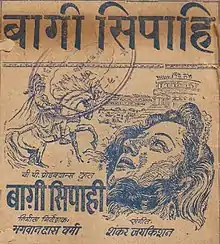Baghi Sipahi (1958 film)
Baghi Sipahi (transl. Rebel Soldier) is a 1958 Indian Hindi-language film directed by Bhagwan Das Varma and starring Madhubala, Chandrashekhar and Ranjan.[1][2][3][4] It is loosely based on the 1951 American film Quo Vadis, which in turn was adapted from the 1896 book with the same title by Henryk Sienkiewicz. The film was distributed and produced by V.P. Productions,[5] an affiliate of Varma Films. Baghi Sipahi was released on 1 January 1958.[6]
| Baghi Sipahi | |
|---|---|
 Poster | |
| Directed by | Bhagwan Das Varma |
| Produced by | Bhagwan Das Varma |
| Starring | Madhubala Chandrashekhar Ranjan |
| Edited by | Dharam Vir |
| Music by | Shankar–Jaikishan |
Production company | V.P. Productions |
| Distributed by | V.P. Productions |
Release date | 1 January 1958 |
| Country | India |
| Language | Hindi |
Baghi Sipahi’s narrative centers around the Roman Empire’s clash with Christianity and the harassment of Christians in its empire. Prominent among the persecuted Christians was the character played by Baghi Sipahi’s lead actress Madhubala, who in the early 1950s had been called “the biggest star in the world” by David Cort of Theatre Arts Magazine.[7] Baghi Sipahi was the third collaboration between its filmmakers and Madhubala. Previously Madhubala and the filmmakers had collaborated in Neki Aur Badi (1949),[8] for which Varma Films was the distributor, and Badal (1951),[9] for which Varma Films was both the producer and the distributor. Baghi Sipahi was, however, the first time that Bhagwan Das Varma, one of the founders of Varma Films, had directed Madhubala.
Plot
Baghi Sipahi is set in Rome in Nero's time, and has a theme based on Christians and their persecution by the Roman Empire.[10]
The film tells the story of a Roman military commander, who, after returning from the war, falls in love with Ranjana, a devout Christian. Ranjana is technically a hostage of the Roman Emperor. However, as a reward for his services, the commander is able to persuade the Emperor to give Ranjana to him. Although Ranjana resents this arrangement, she eventually falls in love with the commander.
As the film progresses, the Emperor's massacres of the Christians become progressively more despicable. When the kingdom catches fire, the Emperor blames the Christians at the suggestion of his wife. This in turn leads to more atrocities toward the Christians, instigating the commander to become a rebel soldier to protect Ranjana and the Christian community.
Much of the movie proceeds with the cruel spectacles that ensue with the increasingly irrational behavior of the Emperor. Ultimately, the commander succeeds in overturning the situation, leading to the demise of the Emperor with the assistance of a palace slave, who was once in unreciprocated love with the Emperor.
Cast
- Madhubala as Ranjana
- Chandrashekhar as the military commander
- Ranjan as the Emperor
- Nishi as the Emperor's wife
- Om Prakash
- Purnima as a palace slave
- Gope
- Sapru
Soundtrack
The soundtrack of Baghi Sipahi was composed by Shankar–Jaikishan.[11][2]
| Track # | Song | Singer(s) | Lyricist |
|---|---|---|---|
| 1 | "Sharab-E-Ishq Ke Aage Muskurati Zindagi Ko Chhod Ke" | Lata Mangeshkar | Shailendra, Hasrat Jaipuri |
| 2 | "Sama Ye Pyar Ka Bahar Ke Ye Mele" | Manna Dey, Asha Bhonsle | |
| 3 | "Chinchan Pappulu Chhui Mui Mai Chhu Na Lena Mujhe" | Manna Dey, Asha Bhonsle | |
| 4 | "Dil Lagane Wale Mat Sun Meri Kahani" | Lata Mangeshkar | |
| 5 | "Aye Dilbar Dil Wale Pyar Pe Marne Wale" | Lata Mangeshkar | |
| 6 | "O Beraham Tere Sitam Hum Pe Honge Kabtak" | Lata Mangeshkar, Manna Day | |
| 7 | "Ruk Ja Musafir Pal Bhar Hi Ruk Ja" | Lata Mangeshkar | |
| 8 | "Maan Bhi Le Dil Tu Apni Ye Haar" | Lata Mangeshkar | |
Reception
Quo Vadis, the 1951 American film on which Baghi Sipahi is based was a box-office hit.[12] Baghi Sipahi was released seven years after the release of its American counterpart and was not successful at the box office.
A review by Thought disliked the fact that Madhubala was present in almost the whole film, but found her to be "vivacious" in her role. The sets and other actors were only formally praised. However, according to Thought, the lavish war scenes were great in visuals.[10]
References
- Akbar, Katijia (2011). I Want to Live: The Story of Madhubala. Hay House. p. 143. ISBN 9789381398210.
- "Baghi Sipahi (1958) - Review, Star Cast, News, Photos". Cinestaan. Retrieved 8 January 2021.
- Rajadhyaksha, Ashish (1994). Encyclopedia of Indian cinema. Taylor & Francis. p. 131. ISBN 9780195635799.
- "BAGHI SIPAHI - Film / Movie". www.citwf.com. Retrieved 22 January 2021.
- "Baghi Sipahi (1958)". myswar.co. Retrieved 12 August 2023.
- Hungama, Bollywood. "Baghi Sipahi - Bollywood Hungama". Bollywood Hungama. Archived from the original on 22 January 2021. Retrieved 16 January 2021.
- Cort, David (4 August 1952). "The Biggest Star in the World—and she's not in the Beverley Hills". Theatre Arts Magazine. pp. 23–26. Retrieved 25 July 2023.
- "Neki Aur Badi (1949) Cast - Actor, Actress, Director, Producer, Music Director". Cinestaan. Retrieved 24 July 2023.
- "Badal (1951)". Bollywood Hungama. Retrieved 24 July 2023.
- Thought. Siddhartha Publications. 1958.
- HindiGeetMala. "Baghi Sipahi : Lyrics and video of Songs from the Movie Baghi Sipahi (1958)". HindiGeetMala. Retrieved 13 January 2021.
- "National Boxoffice Survey". Variety. 9 January 1952. p. 3. Retrieved 13 August 2023.
External links
- Baghi Sipahi at IMDb